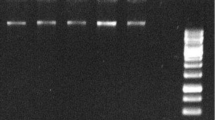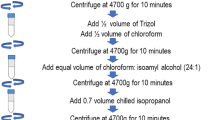Abstract
RNA extraction is the first step in the study of gene isolation and expression. However, it is difficult to extract high quantity and quality RNA from tissues containing large quantities of polysaccharides and polyphenols. Peach (Prunus persica), in addition to containing high levels of polysaccharides and polyphenols, is a challenging starting material for RNA isolation using a single method because of different amounts of those substances in diverse tissues. Based on three reported methods, we developed a modified RNA isolation protocol to solve this problem, leading to high quality and quantity of total RNA from peach mesocarp tissues of fruits which were sampled from all developmental stages and different storage periods, as well as from other tissues including flowers, leaves, stems, and roots. With our modified method, 28–650 μg of total RNA was routinely obtained from per gram of fresh material, gave at least a 1.16-fold improvement by compared with those isolated by other seven methods. The RNA extracts were successfully used in downstream applications such as RT-PCR, RACE, and real-time PCR.



Similar content being viewed by others
References
Logemann, J., Schell, J., & Willmitzer, L. (1987). Improved method for the isolation of RNA from plant tissues. Analytical Biochemistry, 163(1), 16–20.
Gao, J., Liu, J., Li, B., & Li, Z. (2001). Isolation and purification of functional total RNA from blue-grained wheat endosperm tissues containing high levels of starches and flavonoids. Plant Molecular Biology Reporter, 19(2), 185–186.
Reid, K. E., Olsson, N., Schlosser, J., Peng, F., & Lund, S. T. (2006). An optimized grapevine RNA isolation procedure and statistical determination of reference genes for real-time RT-PCR during berry development. BMC Plant Biology, 6(1), 27.
Gambino, G., Perrone, I., & Gribaudo, I. (2008). A rapid and effective method for RNA extraction from different tissues of grapevine and other woody plants. Phytochemical Analysis, 19(6), 520–525.
Hu, C., Honda, C., Kita, M., Zhang, Z., Tsuda, T., & Moriguchi, T. (2002). A simple protocol for RNA isolation from fruit trees containing high levels of polysaccharides and polyphenol compounds. Plant Molecular Biology Reporter, 20(1), 69a–69g.
Meisel, L., Fonseca, B., González, S., Baezayates, R., Cambiazo, V., Campos, R., et al. (2005). A rapid and efficient method for purifying high quality total RNA from peaches (Prunus persica) for functional genomics analyses. Biological Research, 38, 83–88.
Zamboni, A., Pierantoni, L., & De Franceschi, P. (2008). Total RNA extraction from strawberry tree (Arbutus unedo) and several other woody-plants. iForest-Biogeosciences and Forestry, 1(1), 122–125.
Gehrig, H., Winter, K., Cushman, J., Borland, A., & Taybi, T. (2000). An improved RNA isolation method for succulent plant species rich in polyphenols and polysaccharides. Plant Molecular Biology Reporter, 18(4), 369–376.
Claros, M. G., & Cánovas, F. M. (1998). Rapid high quality RNA preparation from pine seedlings. Plant Molecular Biology Reporter, 16(1), 9–18.
Chang, S., Puryear, J., & Cairney, J. (1993). A simple and efficient method for isolating RNA from pine trees. Plant Molecular Biology Reporter, 11(2), 113–116.
Bekesiova, I., Nap, J.-P., & Mlynarova, L. (1999). Isolation of high quality DNA and RNA from leaves of the carnivorous plant Drosera rotundifolia. Plant Molecular Biology Reporter, 17(3), 269–277.
Liu, J. J., Goh, C. J., Loh, C. S., Liu, P., & Pua, E. C. (1998). A method for isolation of total RNA from fruit tissues of banana. Plant Molecular Biology Reporter, 16(1), 87.
Chan, C. X., Teo, S. S., Ho, C. L., Othman, R. Y., & Phang, S. M. (2004). Optimisation of RNA extraction from Gracilaria changii (Gracilariales, Rhodophyta). Journal of Applied Phycology, 16(4), 297–301.
Wang, D., Wang, B., Li, B., Duan, C., & Zhang, J. (2004). Extraction of total RNA from Chrysanthemum containing high levels of phenolic and carbohydrates. Colloids and Surfaces B: Biointerfaces, 36(2), 111–114.
Tattersall, E. A. R., Ergul, A., AlKayal, F., DeLuc, L., Cushman, J. C., & Cramer, G. R. (2005). Comparison of methods for isolating high-quality RNA from leaves of grapevine. American Journal of Enology and Viticulture, 56(4), 400–406.
Kiefer, E., Heller, W., & Ernst, D. (2000). A simple and efficient protocol for isolation of functional RNA from plant tissues rich in secondary metabolites. Plant Molecular Biology Reporter, 18(1), 33–39.
Bustin, S. A., Benes, V., Garson, J. A., Hellemans, J., Huggett, J., Kubista, M., et al. (2009). The MIQE guidelines: Minimum information for publication of quantitative real-time PCR experiments. Clinical Chemistry, 55(4), 611–622.
Bernardo, G. D., Gaudio, S. D., Galderisi, U., Cascino, A., & Cipollaro, M. (2007). Comparative evaluation of different DNA extraction procedures from food samples. Biotechnology Progress, 23(2), 297–301.
Wilfinger, W. W., Mackey, K., & Chomczynski, P. (1997). Effect of pH and ionic strength on the spectrophotometric assessment of nucleic acid purity. BioTechniques, 22(3), 474–481.
Cury, J. A., & Koo, H. (2007). Extraction and purification of total RNA from Sreptococcus mutans biofilms. Analytical Biochemistry, 365(2), 208–214.
Overbergh, L., Giulietti, A., Valckx, D., Decallonne, R., Bouillon, R., & Mathieu, C. (2003). The use of real-time reverse transcriptase PCR for the quantification of cytokine gene expression. Journal of Biomolecular Techniques, 14(1), 33–43.
Fleige, S., & Pfaffl, M. W. (2006). RNA integrity and the effect on the real-time qRT-PCR performance. Molecular Aspects of Medicine, 27(2–3), 126–139.
Crisosto, C. H., Johnson, R. S., Luza, J. G., & Crisosto, G. M. (1994). Irrigation regimes affect fruit soluble solids concentration and rate of water loss of ‘O’Henry’ peaches. HortScience, 29(10), 1169–1171.
Mencarelli, F., Garosi, F., Botondi, R., & Tonutti, P. (1998). Postharvest physiology of peach and nectarine slices. Acta Horticulturae (ISHS), 465, 463–470.
Ziliotto, F., Begheldo, M., Rasori, A., Bonghi, C., & Tonutti, P. (2008). Transcriptome profiling of ripening nectarine (Prunus persica L. Batsch) fruit treated with 1-MCP. Journal of Experimental Botany, 59(10), 2781–2791.
Ruperti, B., Bonghi, C., Rasori, A., Ramina, A., & Tonutti, P. (2001). Characterization and expression of two members of the peach 1-aminocyclopropane-1-carboxylate oxidase gene family. Physiologia Plantarum, 111(3), 336–344.
John, M. E. (1992). An efficient method for isolation of RNA and DNA from plants containing polyphenolics. Nucleic Acids Research, 20(9), 2381.
Malnoy, M., Reynoird, J., Mourgues, F., Chevreau, E., & Simoneau, P. (2001). A method for isolating total RNA from pear leaves. Plant Molecular Biology Reporter, 19(1), 69.
Wang, T., Zhang, N., & Du, L. (2005). Isolation of RNA of high quality and yield from Ginkgo biloba leaves. Biotechnology Letters, 27(9), 629–633.
Kim, S. H., & Hamada, T. (2005). Rapid and reliable method of extracting DNA and RNA from sweetpotato, Ipomoea batatas (L). Lam. Biotechnology Letters, 27(23), 1841–1845.
Wang, X., Tian, W., & Li, Y. (2008). Development of an efficient protocol of RNA isolation from recalcitrant tree tissues. Molecular Biotechnology, 38(1), 57–64.
Acknowledgments
The authors gratefully acknowledge the financial support extended by the National Natural Science Foundation of China (30370987; 30871681) and a project funded by the Priority Academic Program Development of Jiangsu Higher Education Institutions (PAPD) for this study. The authors also greatly appreciate the critical review of the manuscript by Dr. Zhen-Xiang Lu, Lethbridge Research Centre, Agriculture and Agri-Food Canada, Lethbridge, Alberta, Canada.
Author information
Authors and Affiliations
Corresponding authors
Additional information
Z. Tong and S. Qu contributed equally to this work.
Rights and permissions
About this article
Cite this article
Tong, Z., Qu, S., Zhang, J. et al. A Modified Protocol for RNA Extraction from Different Peach Tissues Suitable for Gene Isolation and Real-Time PCR Analysis. Mol Biotechnol 50, 229–236 (2012). https://doi.org/10.1007/s12033-011-9433-3
Published:
Issue Date:
DOI: https://doi.org/10.1007/s12033-011-9433-3




